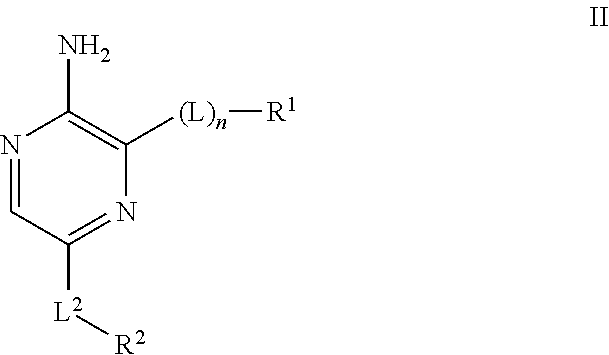Compounds useful as inhibitors of ATR kinase
a technology of atr kinase and compounds, applied in the direction of antibacterial agents, drug compositions, therapy, etc., can solve problems such as dna damage, and achieve the effect of surprising synergy
- Summary
- Abstract
- Description
- Claims
- Application Information
AI Technical Summary
Benefits of technology
Problems solved by technology
Method used
Image
Examples
example 1
5-Amino-6-(6-methyl-1H-benzimidazol-2-yl)-N-(tetrahydrofuran-2-ylmethyl)pyrazine-2-carboxamide (Compound II-52)
[0186]
Method A:
Step 1: Methyl 3-amino-6-bromopyrazine-2-carboxylate
[0187]
[0188]A mixture of methyl 3-aminopyrazine-2-carboxylate (8.35 g, 54.53 mmol) and N-bromo-succinimide (9.705 g, 54.53 mmol) was stirred in MeCN (100 mL) at ambient temperature overnight. The resultant precipitate was filtered, washed with MeCN and dried to give the desired product as a yellow solid (11.68 g, 92% Yield)
[0189]1H NMR (400.0 MHz, DMSO) δ 3.85 (s, 3H), 7.55 (br s, 2H) and 8.42 (s, 1H) ppm; MS (ES+) 233.0.
Step 2: 3-Amino-6-bromopyrazine-2-carboxylic acid
[0190]
[0191]A mixture of methyl 3-amino-6-bromo-pyrazine-2-carboxylate (5.11 g, 22.02 mmol) and lithium hydroxide (2.637 g, 110.1 mmol) in MeOH (20 mL) and H2O (20 mL) was heated to 90° C. for 2 hours. The reaction mixture was allowed to cool and neutralized with HCl and the resultant precipitate collected by filtration. The sub-title product ...
example 2
Methyl 5-amino-6-(6-methyl-1H-benzo[d]imidazol-2-yl)pyrazine-2-carboxylate (Compound II-47)
[0232]
Method B
Step 1: 5-Amino-6-(6-methyl-1H-benzimidazol-2-yl)-N-(tetrahydrofuran-2-ylmethyl)pyrazine-2-carboxamide
[0233]
[0234]5-Bromo-3-(6-methyl-1H-benzimidazol-2-yl)pyrazin-2-amine (70 mg, 0.23 mmol), palladium(+2) cation diacetate (2.6 mg, 0.01 mmol) and sodium carbonate (48.8 mg, 0.46 mmol) were added to toluene (3 mL) and methanol (0.2 mL) and heated to 60° C. under an atmosphere of CO for 1 hour. The residual solids were removed by filtration and the filtrate concentrated in vacuo. The material was purified by reverse phase preparative HPLC [Waters Sunfire C18, 10 mM, 100 Å column, gradient 10%-95% B (solvent A: 0.05% TFA in water; solvent B: CH3CN) over 16 minutes at 25 mL / min]. The fractions were collected and freeze-dried to give the title compound as a yellow solid (29 mg, 40% Yield). MS (ES+) 284.0.
example 3
N-(5-Amino-6-(6-methyl-1H-benzo[d]imidazol-2-yl)pyrazin-2-yl)-2-cyanoethanamide (Compound II-92)
[0235]
Method C
Step 1: tert-Butyl 2-(3-(bis(tert-butoxycarbonyl)amino)-6-bromopyrazin-2-yl)-6-methyl-1H-benzo[d]imidazole-1-carboxylate
[0236]
[0237]A mixture of 5-bromo-3-(6-methyl-1H-benzimidazol-2-yl)pyrazin-2-amine (2.0 g, 6.58 mmol), di-tert-butyl dicarbonate (6.46 g, 29.59 mmol), and DMAP (80.34 mg, 0.658 mmol) in acetonitrile (25 mL) and THF (25 mL) was stirred at ambient temperature for 16 hours. The solvent was removed in vacuo and the residue purified by column chromatography eluting with 20% EtOAc / petroleum ether to give the sub-title product at a colourless foam (10.44 g, 80% Yield). 1H NMR (400.0 MHz, CDCl3) δ 1.37 (18H, s), 1.51-1.52 (9H, 2×s), 2.52-2.54 (3H, 2×s), 7.20-7.28 (m, 1H), 7.56-7.66 (1H, m), 7.87-7.91 (1H, m), 8.67-8.68 (1H, 2×s) ppm; MS (ES+) 606.0.
Step 2: tert-Butyl 2-(3-(bis(tert-butoxycarbonyl)amino)-6-(2-cyanoethanamido)pyrazin-2-yl)-6-methyl-1H-benzo[d]imidazo...
PUM
| Property | Measurement | Unit |
|---|---|---|
| temperature | aaaaa | aaaaa |
| pH | aaaaa | aaaaa |
| temperature | aaaaa | aaaaa |
Abstract
Description
Claims
Application Information
 Login to View More
Login to View More - R&D
- Intellectual Property
- Life Sciences
- Materials
- Tech Scout
- Unparalleled Data Quality
- Higher Quality Content
- 60% Fewer Hallucinations
Browse by: Latest US Patents, China's latest patents, Technical Efficacy Thesaurus, Application Domain, Technology Topic, Popular Technical Reports.
© 2025 PatSnap. All rights reserved.Legal|Privacy policy|Modern Slavery Act Transparency Statement|Sitemap|About US| Contact US: help@patsnap.com



